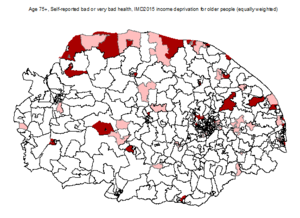Design and Develop
Description of the project and the local area
(Including needs assessment or/and, other data sources available for your target population and area.) Is there a history in your area of social innovation or collaborative action with communities?
Please see Needs Assessment 6.1, 6,2, 6,3 6.4
In the SAIL target areas at the start of the project we weren't aware of any historical projects using Social Innovation however we did not conduct a comprehensive study to investigate this. SAIL in Norfolk is building on a project called Mobile Me which used social innovation methods outside the SAIL target area.
Assets and resources
What assets or resources including expertise has your team got that helped you get started with this project?
Contacts with disabled user groups
Active Norfolk –
- Ryan's experience of working with target audience around physical activity
- Evaluation Officer who helps with collation and justification of areas we work in
- Locality workers who know the SAIL area and relevant stakeholders, resources and assets
UEA – Amanda Burke's experience as a researcher with the target demographic
NCC Env – experience of leading on Interreg projects and knowledge of county countryside assets.
Care settings: providing access, expertise and knowledge around vulnerable older people living with high health deprivation
Community based resource, expertise of their local areas, access to local community and population. Provision of facilities. Opportunity to build on existing services.
Geographical setting
Please describe where your project is based, is your project based in a rural or urban area, area of catchment for participants, is it on single or multiple sites?
In order to help decide in which SAIL should be delivered it was decided to select three indicators relevant to the project’s overarching aims, i.e. the prevalence of older people, levels of health deprivation and, in order to focus on areas of highest disadvantage, income deprivation for older people. These three indicators are referred to in this report as ‘primary indicators’.
In addition to this, a number of secondary indicators were selected that may be useful for directing specific projects (for example, projects focussed on dementia) and/or help with the design and specification of the intervention. These there are referred to in this report as the ‘secondary indicators’.
Mapping the primary indicators
The three primary indicators were combined in order to form a ‘composite indicator’.
The indicators used were as follows:
• % of an LSOA that are aged 75 or over (ONS, 2015 mid-year population estimates downloaded from http://www.norfolkinsight.org.uk/) OR % of an LSOA that are aged 65 or over and single (2011 Census, downloaded from http://www.norfolkinsight.org.uk/)
• % of an LSOA that self-report bad or very bad health (2011 Census, downloaded from http://www.norfolkinsight.org.uk/)
• % of older people in an LSOA are that income deprived (2015 Indices of Multiple Deprivation, downloaded from https://www.gov.uk/government/statistics/english-indices-of-deprivation-2015)
The dark red shading on the map shows LSOA that are in the most disadvantaged decile using, the pink shading shows the LSOAs that are in the second most disadvantaged decile. As two different indicators for age were used, two maps are shown below.
Figure 1. % aged 75 and over, % that self report bad or very bad health and % that are older people income deprived.
Please see the Needs Assessment Section 6 for further details and maps.
Current situation
`What currently happens` in relation to your project problem or issue, is your project new or are you building on an existing project?
We are building on pre-existing work and learnings from a project(Mobile Me) that was delivered within the Norwich and central Norfolk District area i.e. outside the SAIL area and are looking to take this way of working into the relevant SAIL areas and build upon low-level pockets of physical activity that are happening for the target demographic in target SAIL areas.
Demand
What would you anticipate the demand might be for your proposed project at this stage and what are you basing that forecast on?
Expansion
Are you planning to expand an already-successful project with a different population or in a different setting? Please describe your reasons for this and what information you used to inform your decision?
Information capture for your project
Please make a plan and decide what strategies you are going to use and when. As a minimum everyone needs to keep their meeting minutes/notes and attendance details. Other ideas are photos/videos/diaries/attendance numbers/participant feedback/log book. In relation to the SAIL feasibility study you will need to be able to say who attended your project and when also including the participants age and gender if possible.
Acceptability
How was the project proposal recieved by a) your team members/organisational partners b) your target community/potential participants? Evidence would include: participant observation at initial project meetings, qualitative interviews with participants and project staff or correspondence related to the proposal ie emails exchanges?
Adaptation
Have you made any changes to your original plans, why did you make the change and what information did you base your new plans on?
Key stakeholders and relations
Are there key individuals, (including participants) organisations or relationships who are central to your project, and in what way do they benefit your project?

